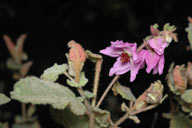In Flower This Week
A news sheet prepared by a Gardens' volunteer.
Numbers before each plant refer to temporary IFTW labels in the gardens.
Numbers in square brackets [ ] refer to garden bed Sections. Plants in flower are in bold type.
View past issues of 'In Flower This Week'.
30 September 2015
Thomasia tenuivestita click for larger image |
We will walk to the waterfall today, seeing plenty of flowering plants along the way.
- Turn right as you exit the Visitor Information Centre (VIC) to see on your right in a pot Telopea ‘Essie’s Gift’, with long green leaves and spectacular dark pink flowers. Essie's Gift' is a new selection and is named in honour of the late Essie Huxley who was devoted to the genus Telopea.
- Also on your right is Philotheca myoporoides subsp. acuta [Section 174], with masses of white star flowers with pink buds on a neat shrub. This plant is native to central west New South Wales.
- Further on your right is Phebalium daviesii [Section 174], or St. Helens Wax Flower, a small shrub with bright green leaves and yellow star flowers. In the wild this plant is restricted to a small area in north-east Tasmania.
- Acacia cognata ‘Green Mist’ [Section 210], on the left, is a weeping shrub with green linear leaves and yellow balls of flowers. It is a dwarf form of the Bower Wattle, Acacia cognata.
- Before you cross the bridge look to your right to see Rhodanthe anthemoides [Section 60], a mound of grey-green foliage almost covered with white daisy flowers with gold centres. Also known as Chamomile Sunray, this plant is widespread in mainland Australia but listed as rare in Tasmania.
- Go across the bridge and past the café to see on your left Micromyrtus ciliata [Section 131], or Fringed Heath Myrtle, with arching stems, close green foliage and clusters of small white flowers with maroon centres. It is native to southeastern mainland Australia.
- Turn left up the hill on the road to see on your left Westringia longifolia ‘Wandin Gem’ [Section 119], a large lax shrub with small dark foliage and pale mauve flowers.
- On your right is Eremophila drummondii [Section 302], a small shrub with sticky green foliage and mauve tubular flowers. It is found in the wild in southwestern Western Australia.
- On your left is Grevillea aspleniifolia [Section 124], a very large sprawling shrub with long linear toothed green foliage and pink toothbrush flowers. It is endemic to New South Wales.
- A group of Westringia longifolia [Section 6] on your right are large shrubs with small green leaves and masses of white flowers. This plant is found from central New South Wales to southern Queensland.
- Across from the waterfall on your right is Thomasia tenuivestita [Section 4], a small shrub with pale green foliage and purple flowers with dark red centres. It is found in the wild in southwestern Western Australia.
- Guichenotia ledifolia, [Section 4] on your right, has grey-green foliage covered in masses of dusty pink five-petalled flowers with maroon centres. It is native to south western WA.
- In front of the waterfall on your left is Indigofera australis [Section 15x], a small straggly shrub with pink flowers. It is a member of the pea family and is found in all states of Australia.
- Just past the waterfall on your left is Grevillea saccata [Section 15s], a shrub with weeping branches of bright green upright leaves and striking pinkish-orange flowers. Grevillea saccata is commonly known as Pouched Grevillea, and is endemic to southwestern Western Australia.
- Also on your left is Acacia acinacea [Section 15r], or Gold Dust Wattle, a small shrub with green leaves smothered in gold balls of flowers. It is native to southeastern mainland Australia.
Rosalind Walcott
![Director of National Parks [logo]](../../../../images/dnp_90px.gif)







